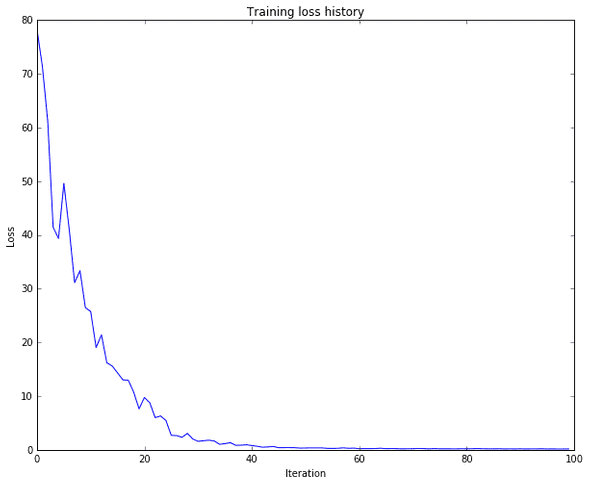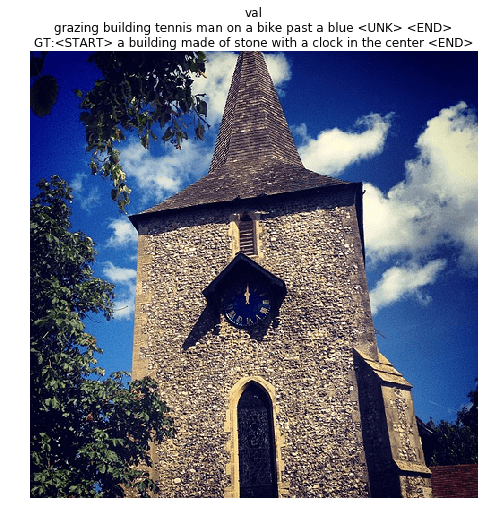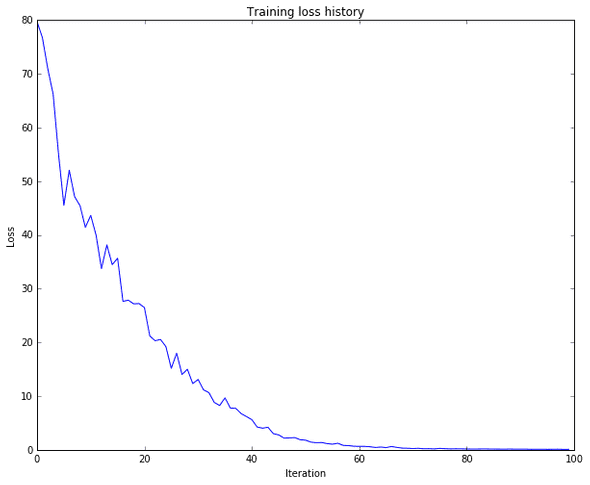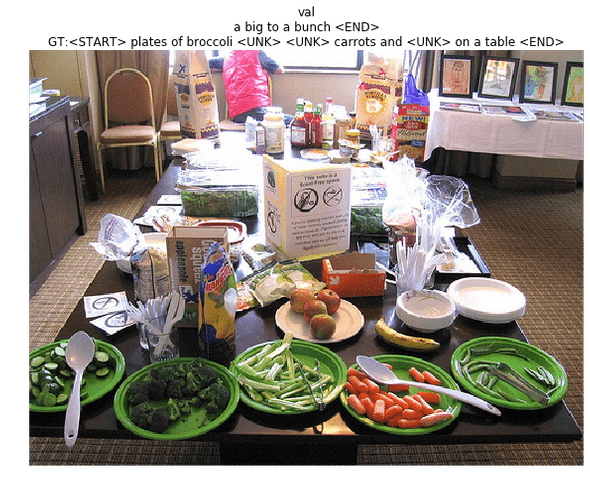cs231n: Practical Machine Learning Project 2
November 10, 2016
Option 1. Image Captioning using RNN and LSTM
Q1: Image Captioning with Vanilla RNNs
The IPython notebook RNN_Captioning.ipynb walk through the implementation of an image captioning system on MS-COCO using vanilla recurrent networks.
The file cs231n/rnn_layers.py contains implementations of different layer types that are needed for recurrent neural networks. The file cs231n/classifiers/rnn.py contains implementations of CaptioningRNN class.
run the following command
ipython notebook RNN_Captioning.ipynbresult
code: in cs231n/classifiers/rnn.py
def loss(self, features, captions):
"""
Compute training-time loss for the RNN. We input image features and
ground-truth captions for those images, and use an RNN (or LSTM) to compute
loss and gradients on all parameters.
Inputs:
- features: Input image features, of shape (N, D)
- captions: Ground-truth captions; an integer array of shape (N, T) where
each element is in the range 0 <= y[i, t] < V
Returns a tuple of:
- loss: Scalar loss
- grads: Dictionary of gradients parallel to self.params
"""
# Cut captions into two pieces: captions_in has everything but the last word
# and will be input to the RNN; captions_out has everything but the first
# word and this is what we will expect the RNN to generate. These are offset
# by one relative to each other because the RNN should produce word (t+1)
# after receiving word t. The first element of captions_in will be the START
# token, and the first element of captions_out will be the first word.
captions_in = captions[:, :-1]
captions_out = captions[:, 1:]
# You'll need this
mask = (captions_out != self._null)
# Weight and bias for the affine transform from image features to initial
# hidden state
W_proj, b_proj = self.params['W_proj'], self.params['b_proj']
# Word embedding matrix
W_embed = self.params['W_embed']
# Input-to-hidden, hidden-to-hidden, and biases for the RNN
Wx, Wh, b = self.params['Wx'], self.params['Wh'], self.params['b']
# Weight and bias for the hidden-to-vocab transformation.
W_vocab, b_vocab = self.params['W_vocab'], self.params['b_vocab']
loss, grads = 0.0, {}
############################################################################
# TODO: Implement the forward and backward passes for the CaptioningRNN. #
# In the forward pass you will need to do the following: #
# (1) Use an affine transformation to compute the initial hidden state #
# from the image features. This should produce an array of shape (N, H)#
# (2) Use a word embedding layer to transform the words in captions_in #
# from indices to vectors, giving an array of shape (N, T, W). #
# (3) Use either a vanilla RNN or LSTM (depending on self.cell_type) to #
# process the sequence of input word vectors and produce hidden state #
# vectors for all timesteps, producing an array of shape (N, T, H). #
# (4) Use a (temporal) affine transformation to compute scores over the #
# vocabulary at every timestep using the hidden states, giving an #
# array of shape (N, T, V). #
# (5) Use (temporal) softmax to compute loss using captions_out, ignoring #
# the points where the output word is <NULL> using the mask above. #
# #
# In the backward pass you will need to compute the gradient of the loss #
# with respect to all model parameters. Use the loss and grads variables #
# defined above to store loss and gradients; grads[k] should give the #
# gradients for self.params[k]. #
############################################################################
affine_out, affine_cache = affine_forward(features, W_proj, b_proj)
embed_out, embed_cache = word_embedding_forward(captions_in, W_embed)
forward = rnn_forward if self.cell_type == 'rnn' else lstm_forward
forward_out, forward_cache = forward(embed_out, affine_out, Wx, Wh, b)
temporal_out, temporal_cache = temporal_affine_forward(forward_out, W_vocab, b_vocab)
loss, dx = temporal_softmax_loss(temporal_out, captions_out, mask, False)
drnn, dW_vocab, db_vocab = temporal_affine_backward(dx, temporal_cache)
backward = rnn_backward if self.cell_type == 'rnn' else lstm_backward
dembed, daffine, dWx, dWh, db = backward(drnn, forward_cache)
dW_embed = word_embedding_backward(dembed, embed_cache)
dx, dW_proj, db_proj = affine_backward(daffine, affine_cache)
grads = {'W_vocab':dW_vocab,'b_vocab':db_vocab,'Wx':dWx,'Wh':dWh,'b':db,
'W_embed':dW_embed,'W_proj':dW_proj,'b_proj':db_proj}
############################################################################
# END OF YOUR CODE #
############################################################################
return loss, gradsin cs231n/classifiers/rnn.py
def sample(self, features, max_length=30):
"""
Run a test-time forward pass for the model, sampling captions for input
feature vectors.
At each timestep, we embed the current word, pass it and the previous hidden
state to the RNN to get the next hidden state, use the hidden state to get
scores for all vocab words, and choose the word with the highest score as
the next word. The initial hidden state is computed by applying an affine
transform to the input image features, and the initial word is the <START>
token.
For LSTMs you will also have to keep track of the cell state; in that case
the initial cell state should be zero.
Inputs:
- features: Array of input image features of shape (N, D).
- max_length: Maximum length T of generated captions.
Returns:
- captions: Array of shape (N, max_length) giving sampled captions,
where each element is an integer in the range [0, V). The first element
of captions should be the first sampled word, not the <START> token.
"""
N = features.shape[0]
captions = self._null * np.ones((N, max_length), dtype=np.int32)
# Unpack parameters
W_proj, b_proj = self.params['W_proj'], self.params['b_proj']
W_embed = self.params['W_embed']
Wx, Wh, b = self.params['Wx'], self.params['Wh'], self.params['b']
W_vocab, b_vocab = self.params['W_vocab'], self.params['b_vocab']
###########################################################################
# TODO: Implement test-time sampling for the model. You will need to #
# initialize the hidden state of the RNN by applying the learned affine #
# transform to the input image features. The first word that you feed to #
# the RNN should be the <START> token; its value is stored in the #
# variable self._start. At each timestep you will need to do to: #
# (1) Embed the previous word using the learned word embeddings #
# (2) Make an RNN step using the previous hidden state and the embedded #
# current word to get the next hidden state. #
# (3) Apply the learned affine transformation to the next hidden state to #
# get scores for all words in the vocabulary #
# (4) Select the word with the highest score as the next word, writing it #
# to the appropriate slot in the captions variable #
# #
# For simplicity, you do not need to stop generating after an <END> token #
# is sampled, but you can if you want to. #
# #
# HINT: You will not be able to use the rnn_forward or lstm_forward #
# functions; you'll need to call rnn_step_forward or lstm_step_forward in #
# a loop. #
###########################################################################
if self.cell_type == 'rnn':
prev_word = np.zeros((N, 1), dtype=np.int32) + self._start
prev_h, affine_cache = affine_forward(features, W_proj, b_proj)
for t in xrange(max_length):
embed_out, embed_cache = word_embedding_forward(prev_word, W_embed)
embed_out = embed_out.reshape((embed_out.shape[0],embed_out.shape[2]))
h, rnn_cache = rnn_step_forward(embed_out, prev_h, Wx, Wh, b)
scores, affine_cache = affine_forward(h, W_vocab, b_vocab)
prev_word = captions[:, t] = scores.argmax(axis=1)
prev_word = prev_word.reshape(N, 1)
prev_h = h
else:
prev_word = np.zeros((N, 1), dtype=np.int32) + self._start
prev_h, affine_cache = affine_forward(features, W_proj, b_proj)
N, H = prev_h.shape
prev_c = np.zeros((N,H))
for t in xrange(max_length):
embed_out, embed_cache = word_embedding_forward(prev_word, W_embed)
embed_out = embed_out.reshape((embed_out.shape[0],embed_out.shape[2]))
h, c, lstm_cache = lstm_step_forward(embed_out, prev_c, prev_h, Wx, Wh, b)
scores, affine_cache = affine_forward(h, W_vocab, b_vocab)
prev_word = captions[:, t] = scores.argmax(axis=1)
prev_word = prev_word.reshape(N, 1)
prev_h = h
prev_c = c
############################################################################
# END OF YOUR CODE #
############################################################################
return captionsQ2: Image Captioning with LSTMs
The IPython notebook LSTM_Captioning.ipynb walk through the implementation of Long-Short Term Memory (LSTM) RNNs, and apply them to image captioning on MS-COCO.
The file cs231n/rnn_layers.py contains implementations of different layer types that are needed for LSTM. The file cs231n/classifiers/rnn.py contains implementations of CaptioningRNN class.
run the following command
ipython notebook LSTM_Captioning.ipynbresult
code: in cs231n/rnn_layers.py
def rnn_step_forward(x, prev_h, Wx, Wh, b):
"""
Run the forward pass for a single timestep of a vanilla RNN that uses a tanh
activation function.
The input data has dimension D, the hidden state has dimension H, and we use
a minibatch size of N.
Inputs:
- x: Input data for this timestep, of shape (N, D).
- prev_h: Hidden state from previous timestep, of shape (N, H)
- Wx: Weight matrix for input-to-hidden connections, of shape (D, H)
- Wh: Weight matrix for hidden-to-hidden connections, of shape (H, H)
- b: Biases of shape (H,)
Returns a tuple of:
- next_h: Next hidden state, of shape (N, H)
- cache: Tuple of values needed for the backward pass.
"""
next_h, cache = None, None
##############################################################################
# TODO: Implement a single forward step for the vanilla RNN. Store the next #
# hidden state and any values you need for the backward pass in the next_h #
# and cache variables respectively. #
##############################################################################
next_h = np.tanh(np.dot(x, Wx) + np.dot(prev_h, Wh) + b)
cache = (x, prev_h, Wx, Wh, next_h)
##############################################################################
# END OF YOUR CODE #
##############################################################################
return next_h, cachein cs231n/rnn_layers.py
def rnn_step_backward(dnext_h, cache):
"""
Backward pass for a single timestep of a vanilla RNN.
Inputs:
- dnext_h: Gradient of loss with respect to next hidden state
- cache: Cache object from the forward pass
Returns a tuple of:
- dx: Gradients of input data, of shape (N, D)
- dprev_h: Gradients of previous hidden state, of shape (N, H)
- dWx: Gradients of input-to-hidden weights, of shape (N, H)
- dWh: Gradients of hidden-to-hidden weights, of shape (H, H)
- db: Gradients of bias vector, of shape (H,)
"""
dx, dprev_h, dWx, dWh, db = None, None, None, None, None
##############################################################################
# TODO: Implement the backward pass for a single step of a vanilla RNN. #
# #
# HINT: For the tanh function, you can compute the local derivative in terms #
# of the output value from tanh. #
##############################################################################
x, prev_h, Wx, Wh, next_h = cache
dt = (1 - next_h ** 2) * dnext_h
dx = np.dot(dt, np.transpose(Wx))
dprev_h = np.dot(dt, np.transpose(Wh))
dWx = np.dot(np.transpose(x), dt)
dWh = np.dot(np.transpose(prev_h), dt)
db = np.sum(dt, axis=0)
##############################################################################
# END OF YOUR CODE #
##############################################################################
return dx, dprev_h, dWx, dWh, dbin cs231n/rnn_layers.py
def rnn_forward(x, h0, Wx, Wh, b):
"""
Run a vanilla RNN forward on an entire sequence of data. We assume an input
sequence composed of T vectors, each of dimension D. The RNN uses a hidden
size of H, and we work over a minibatch containing N sequences. After running
the RNN forward, we return the hidden states for all timesteps.
Inputs:
- x: Input data for the entire timeseries, of shape (N, T, D).
- h0: Initial hidden state, of shape (N, H)
- Wx: Weight matrix for input-to-hidden connections, of shape (D, H)
- Wh: Weight matrix for hidden-to-hidden connections, of shape (H, H)
- b: Biases of shape (H,)
Returns a tuple of:
- h: Hidden states for the entire timeseries, of shape (N, T, H).
- cache: Values needed in the backward pass
"""
h, cache = None, None
##############################################################################
# TODO: Implement forward pass for a vanilla RNN running on a sequence of #
# input data. You should use the rnn_step_forward function that you defined #
# above. #
##############################################################################
N, T, D = x.shape
N, H = h0.shape
h = np.zeros((N, T, H))
cache = []
prev_h = h0
for i in xrange(T):
prev_h, _cache = rnn_step_forward(x[:, i, :], prev_h, Wx, Wh, b)
cache.append(_cache)
h[:, i, :] = prev_h
##############################################################################
# END OF YOUR CODE #
##############################################################################
return h, cachein cs231n/rnn_layers.py
def rnn_backward(dh, cache):
"""
Compute the backward pass for a vanilla RNN over an entire sequence of data.
Inputs:
- dh: Upstream gradients of all hidden states, of shape (N, T, H)
Returns a tuple of:
- dx: Gradient of inputs, of shape (N, T, D)
- dh0: Gradient of initial hidden state, of shape (N, H)
- dWx: Gradient of input-to-hidden weights, of shape (D, H)
- dWh: Gradient of hidden-to-hidden weights, of shape (H, H)
- db: Gradient of biases, of shape (H,)
"""
dx, dh0, dWx, dWh, db = None, None, None, None, None
##############################################################################
# TODO: Implement the backward pass for a vanilla RNN running an entire #
# sequence of data. You should use the rnn_step_backward function that you #
# defined above. #
##############################################################################
N, T, H = dh.shape
N, D = cache[0][0].shape
dx = np.zeros((N, T, D))
dh0 = np.zeros((N, H))
dWx = np.zeros((D, H))
dWh = np.zeros((H, H))
db = np.zeros(H)
dprevh= np.zeros((N, H))
for i in xrange(T - 1, -1, -1):
t_dx, t_dprevh, t_dWx, t_dWh, t_db = rnn_step_backward(dh[:,i,:] + dprevh, cache[i])
dx[:,i,:] = t_dx
dWx += t_dWx
dWh += t_dWh
db += t_db
dprevh = t_dprevh
dh0 = dprevh
##############################################################################
# END OF YOUR CODE #
##############################################################################
return dx, dh0, dWx, dWh, dbin cs231n/rnn_layers.py
def word_embedding_forward(x, W):
"""
Forward pass for word embeddings. We operate on minibatches of size N where
each sequence has length T. We assume a vocabulary of V words, assigning each
to a vector of dimension D.
Inputs:
- x: Integer array of shape (N, T) giving indices of words. Each element idx
of x muxt be in the range 0 <= idx < V.
- W: Weight matrix of shape (V, D) giving word vectors for all words.
Returns a tuple of:
- out: Array of shape (N, T, D) giving word vectors for all input words.
- cache: Values needed for the backward pass
"""
out, cache = None, None
##############################################################################
# TODO: Implement the forward pass for word embeddings. #
# #
# HINT: This should be very simple. #
##############################################################################
N, T = x.shape
V, D = W.shape
out = np.zeros((N, T, D))
for i in xrange(N):
for j in xrange(T):
out[i, j] = W[x[i, j]]
cache = (x, W, out)
##############################################################################
# END OF YOUR CODE #
##############################################################################
return out, cachein cs231n/rnn_layers.py
def word_embedding_backward(dout, cache):
"""
Backward pass for word embeddings. We cannot back-propagate into the words
since they are integers, so we only return gradient for the word embedding
matrix.
HINT: Look up the function np.add.at
Inputs:
- dout: Upstream gradients of shape (N, T, D)
- cache: Values from the forward pass
Returns:
- dW: Gradient of word embedding matrix, of shape (V, D).
"""
dW = None
##############################################################################
# TODO: Implement the backward pass for word embeddings. #
# #
# HINT: Look up the function np.add.at #
##############################################################################
x, W, o = cache
dW = np.zeros((W.shape[0], dout.shape[2]))
np.add.at(dW, x, dout)
##############################################################################
# END OF YOUR CODE #
##############################################################################
return dWin cs231n/rnn_layers.py
def lstm_step_forward(x, prev_h, prev_c, Wx, Wh, b):
"""
Forward pass for a single timestep of an LSTM.
The input data has dimension D, the hidden state has dimension H, and we use
a minibatch size of N.
Inputs:
- x: Input data, of shape (N, D)
- prev_h: Previous hidden state, of shape (N, H)
- prev_c: previous cell state, of shape (N, H)
- Wx: Input-to-hidden weights, of shape (D, 4H)
- Wh: Hidden-to-hidden weights, of shape (H, 4H)
- b: Biases, of shape (4H,)
Returns a tuple of:
- next_h: Next hidden state, of shape (N, H)
- next_c: Next cell state, of shape (N, H)
- cache: Tuple of values needed for backward pass.
"""
next_h, next_c, cache = None, None, None
#############################################################################
# TODO: Implement the forward pass for a single timestep of an LSTM. #
# You may want to use the numerically stable sigmoid implementation above. #
#############################################################################
N, H = prev_h.shape
a = np.dot(prev_h, Wh) + np.dot(x, Wx) + b
i = sigmoid(a[:,:H])
f = sigmoid(a[:,H:2*H])
o = sigmoid(a[:,2*H:3*H])
g = np.tanh(a[:,3*H:])
next_c = g*i + prev_c*f
next_h = np.tanh(next_c) * o
cache = (next_c, i, f, o, g, a, x, Wx, Wh, prev_h, prev_c)
##############################################################################
# END OF YOUR CODE #
##############################################################################
return next_h, next_c, cachein cs231n/rnn_layers.py
def lstm_step_backward(dnext_h, dnext_c, cache):
"""
Backward pass for a single timestep of an LSTM.
Inputs:
- dnext_h: Gradients of next hidden state, of shape (N, H)
- dnext_c: Gradients of next cell state, of shape (N, H)
- cache: Values from the forward pass
Returns a tuple of:
- dx: Gradient of input data, of shape (N, D)
- dprev_h: Gradient of previous hidden state, of shape (N, H)
- dprev_c: Gradient of previous cell state, of shape (N, H)
- dWx: Gradient of input-to-hidden weights, of shape (D, 4H)
- dWh: Gradient of hidden-to-hidden weights, of shape (H, 4H)
- db: Gradient of biases, of shape (4H,)
"""
dx, dh, dc, dWx, dWh, db = None, None, None, None, None, None
#############################################################################
# TODO: Implement the backward pass for a single timestep of an LSTM. #
# #
# HINT: For sigmoid and tanh you can compute local derivatives in terms of #
# the output value from the nonlinearity. #
#############################################################################
next_c, i, f, o, g, a, x, Wx, Wh, prev_h, prev_c = cache
dnext_c = dnext_c + (dnext_h*o) * (1 - np.tanh(next_c)**2)
dprev_c = dnext_c*f
di = g*dnext_c
df = dnext_c*prev_c
do = np.tanh(next_c)*dnext_h
dg = dnext_c*i
da = np.zeros(a.shape)
H = next_c.shape[1]
da[:,:H] = di*i*(1-i)
da[:,H:2*H] = df*f*(1-f)
da[:,2*H:3*H] = do*o*(1-o)
da[:,3*H:] = dg*(1-g**2)
db = np.sum(da, axis=0)
dWx = np.dot(np.transpose(x), da)
dWh = np.dot(np.transpose(prev_h), da)
dx = np.dot(da, np.transpose(Wx))
dprev_h = np.dot(da, np.transpose(Wh))
##############################################################################
# END OF YOUR CODE #
##############################################################################
return dx, dprev_h, dprev_c, dWx, dWh, dbin cs231n/rnn_layers.py
def lstm_forward(x, h0, Wx, Wh, b):
"""
Forward pass for an LSTM over an entire sequence of data. We assume an input
sequence composed of T vectors, each of dimension D. The LSTM uses a hidden
size of H, and we work over a minibatch containing N sequences. After running
the LSTM forward, we return the hidden states for all timesteps.
Note that the initial cell state is passed as input, but the initial cell
state is set to zero. Also note that the cell state is not returned; it is
an internal variable to the LSTM and is not accessed from outside.
Inputs:
- x: Input data of shape (N, T, D)
- h0: Initial hidden state of shape (N, H)
- Wx: Weights for input-to-hidden connections, of shape (D, 4H)
- Wh: Weights for hidden-to-hidden connections, of shape (H, 4H)
- b: Biases of shape (4H,)
Returns a tuple of:
- h: Hidden states for all timesteps of all sequences, of shape (N, T, H)
- cache: Values needed for the backward pass.
"""
h, cache = None, None
#############################################################################
# TODO: Implement the forward pass for an LSTM over an entire timeseries. #
# You should use the lstm_step_forward function that you just defined. #
#############################################################################
N, T, D = x.shape
N, H = h0.shape
h = np.zeros((N, T, H))
prev_h = h0
prev_c = np.zeros((N, H))
cache = []
for t in xrange(T):
prev_h, prev_c, t_cache = lstm_step_forward(x[:,t,:],prev_h,prev_c,Wx,Wh,b)
h[:,t,:] = prev_h
cache.append(t_cache)
cache = (cache, D)
##############################################################################
# END OF YOUR CODE #
##############################################################################
return h, cachein cs231n/rnn_layers.py
def lstm_backward(dh, cache):
"""
Backward pass for an LSTM over an entire sequence of data.]
Inputs:
- dh: Upstream gradients of hidden states, of shape (N, T, H)
- cache: Values from the forward pass
Returns a tuple of:
- dx: Gradient of input data of shape (N, T, D)
- dh0: Gradient of initial hidden state of shape (N, H)
- dWx: Gradient of input-to-hidden weight matrix of shape (D, 4H)
- dWh: Gradient of hidden-to-hidden weight matrix of shape (H, 4H)
- db: Gradient of biases, of shape (4H,)
"""
dx, dh0, dWx, dWh, db = None, None, None, None, None
#############################################################################
# TODO: Implement the backward pass for an LSTM over an entire timeseries. #
# You should use the lstm_step_backward function that you just defined. #
#############################################################################
N, T, H = dh.shape
cache, D = cache
dx = np.zeros((N, T, D))
dh0 = np.zeros((N, H))
dWx = np.zeros((D, 4*H))
dWh = np.zeros((H, 4*H))
db = np.zeros((4*H,))
dprev_h = np.zeros((N, H))
dprev_c = np.zeros((N, H))
for i in xrange(T-1, -1, -1):
dx_i,dprev_h,dprev_c,dWx_i,dWh_i,db_i = lstm_step_backward(dh[:,i,:]+dprev_h,dprev_c,cache[i])
dx[:,i,:] = dx_i
dWh += dWh_i
dWx += dWx_i
db += db_i
dh0 = dprev_h
##############################################################################
# END OF YOUR CODE #
##############################################################################
return dx, dh0, dWx, dWh, db








